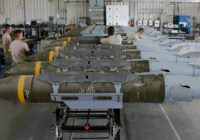Eagle-eyed and skyward gazing Billings Gazette editor Chase Doak first spotted the Chinese dirigible that would traipse across the US for 8 days and set off a firestorm. During that time the American public coalesced against this intrusion, and a sharply-divided Congress voted unanimously on a resolution “Condemning the Chinese Communist Party’s use of a high-altitude surveillance balloon over United States territory as a brazen violation of United States sovereignty.”
The balloon’s travels ended at 14.39 local time (19:39 GMT) on Saturday, February 4 when a US Air Force F-22 shot down what the US stated was a Chinese spy balloon. Meanwhile, the Chinese have maintained the balloon was a “weather monitoring device.” Not long after the first balloon was spotted, another hapless Chinese balloon was identified. The second zeppelin supposedly “seriously deviated” off course over Latin America and the Caribbean, but the proliferation of Chinese balloons seems to reveal broader ambitions. Nor have these ambitions sprung out of nowhere. In recent days, US officials have stated this was not the first time a Chinese balloon has entered US airspace, and they have recently identified at least four other occasions where the weather strangely coincided with large US military interests in Texas, Florida, Hawaii, and Guam. US officials have revealed that the downed balloon was 200 feet (about 60 meters) tall and carried an airliner-sized load of intelligence-gathering equipment. In the high stakes game of weather, size matters.
On Sunday, Rep. Mike Turner, the Republican chairman of the House Intelligence Committee, said on NBC News’ Meet the Press, “If you ask somebody to draw an X at every place where our sensitive missile defense sites, our nuclear weapons infrastructure, our nuclear weapon sites are, you would put them all along this path.” The balloon transited, and at points loitered, over areas that included the 341st Missile Wing at Malmstrom Air Force Base in Billings, Montana, which is home to one of three US Air Force bases that operate and maintain intercontinental ballistic missiles.
US Secretary of State Antony Blinken canceled his visit to China, China is miffed, with Beijing claiming the US used “indiscriminate force,” and everyone is curious about these enormous dirigibles.
What is the backstory of spy balloons?
China is not the first to use spy balloons. They first came into use in the late 19th century for military reconnaissance and observation. During World War I, Germany, France and Britain used unmanned balloons equipped with cameras to gather intelligence.
During the Cold War, both the United States and the Soviet Union employed aerial reconnaissance balloons to gather intelligence on each other’s military capabilities. Even then, these balloons were often equipped with sensors and cameras to monitor troop movements and military assets. With the development of satellite technology, spy balloons became less common. However, as China just demonstrated, they still have niche uses in some military and intelligence operations, and many predict a resurgence in the value of such aircraft.
The Soviets used spy balloons extensively, which were equipped with cameras, sensors, and other monitoring equipment. Launched from Soviet territory, these balloons floated across the Arctic and then drifted across North America. The Chinese seem to be following a similar playbook.
Was the Soviet spy balloon program a success?
The Soviet spy balloon program was one of the largest and most sophisticated military intelligence gathering operations of the Cold War. Soviet balloons gathered intelligence for extended periods of time and provided valuable information about NATO military installations and movements of NATO forces.
Balloons were not without their vulnerabilities. Then, as now, they could be intercepted and shot down easily as the Chinese just discovered. Additionally, balloons of the past were affected by weather conditions, making it difficult to maintain a stable flight path and gather accurate intelligence. Technology has evolved, and the Chinese have increasingly taken interest in navigation tools and patents for dirigibles, making them more stealthy, stable, and reliable.
On the whole, the Soviet spy balloon program was a significant success. Balloons fell out of fashion because advanced satellite technology proved to be more reliable and less vulnerable. More importantly, the Soviet Union collapsed and its balloon program came to an end. Might China be starting off where the Soviets stopped?
[This article was produced with assistance from ChatGPT.]
The views expressed in this article are the author’s own and do not necessarily reflect Fair Observer’s editorial policy.
Support Fair Observer
We rely on your support for our independence, diversity and quality.
For more than 10 years, Fair Observer has been free, fair and independent. No billionaire owns us, no advertisers control us. We are a reader-supported nonprofit. Unlike many other publications, we keep our content free for readers regardless of where they live or whether they can afford to pay. We have no paywalls and no ads.
In the post-truth era of fake news, echo chambers and filter bubbles, we publish a plurality of perspectives from around the world. Anyone can publish with us, but everyone goes through a rigorous editorial process. So, you get fact-checked, well-reasoned content instead of noise.
We publish 2,500+ voices from 90+ countries. We also conduct education and training programs
on subjects ranging from digital media and journalism to writing and critical thinking. This
doesn’t come cheap. Servers, editors, trainers and web developers cost
money.
Please consider supporting us on a regular basis as a recurring donor or a
sustaining member.
Will you support FO’s journalism?
We rely on your support for our independence, diversity and quality.






